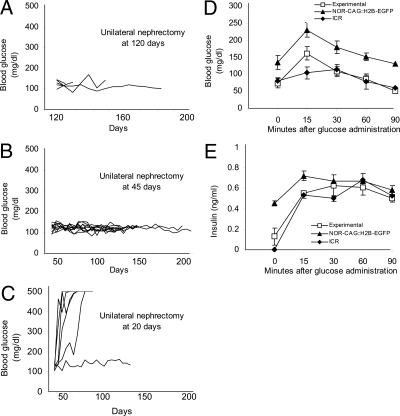Figure 3.
Unilateral nephrectomy reveals that, after 45 d, the graft site is not necessary for maintenance of normal blood glucose levels or metabolic control of blood glucose. A–C, Blood glucose levels of the diabetic NOD mice receiving the combination treatment of anti-CD3 antibody, six to 10 pancreatic anlagen, and an insulin pellet and undergoing a unilateral nephrectomy to remove the pancreatic anlagen graft site at 120 d[n = 5; F(ab′)2 antibody] (A), 45 d [n = 10; three received whole antibody, seven received F(ab′)2 antibody] (B), or 20 d [n = 6; four received whole antibody, two received F(ab′)2 antibody] (C). The insulin pellet was removed before unilateral nephrectomy at 120 or 45 d but remained in place in the mice nephrectomized at 20 d. With removal of the graft site at 120 or 45 d, all the mice maintained normoglycemia (A and B), whereas removal of the graft site after 20 d resulted in five of the six mice failing to maintain normoglycemia (C). Two weeks after nephrectomy at 45 d, seven mice were given an IPGTT (D), and glucose stimulated insulin secretion was measured in six of these by ELISA (E) and compared with nondiabetic, age-matched NOR-CAG::H2B-EGFP (n = 3) and ICR (n = 4) mice. Blood glucose and insulin secretion were measured on blood or serum samples, respectively, collected at intervals after an ip injection of d-glucose after a 14-h fast. The pattern of response, an initial increase followed by gradual decline, was similar in all three groups.

